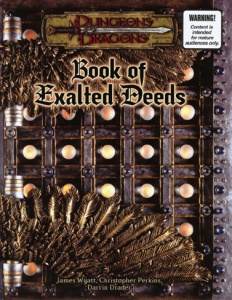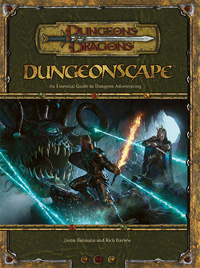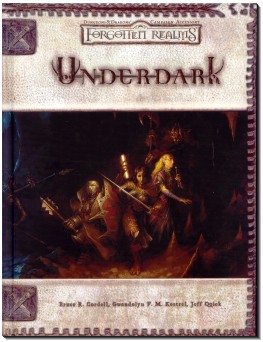
Vecna is a fictional character appearing in the Dungeons & Dragons fantasy role-playing game. Vecna has been named one of the greatest villains in Dungeons & Dragons.
In the Dungeons & Dragons fantasy role-playing game, psionics are a form of supernatural power similar to, but distinct from, arcane and divine magic.

HeroQuest, sometimes written as Hero Quest, is an adventure board game created by Milton Bradley in conjunction with the British company Games Workshop. The game was loosely based around archetypes of fantasy role-playing games: the game itself was actually a game system, allowing the gamemaster to create dungeons of their own design using the provided game board, tiles, furnishings and figures. The game manual describes Morcar/Zargon as a former apprentice of Mentor, and the parchment text is read aloud from Mentor's perspective. Several expansions were released, each adding new tiles, traps, artifacts, and monsters to the core system.

Ravenloft is an adventure module for the Dungeons & Dragons (D&D) fantasy role-playing game. The American game publishing company TSR, Inc. released it as a standalone adventure booklet in 1983 for use with the first edition Advanced Dungeons & Dragons game. It was written by Tracy and Laura Hickman, and includes art by Clyde Caldwell with maps by David Sutherland III. The plot of Ravenloft focuses on the villain Strahd von Zarovich, a vampire who pines for his lost love. Various story elements, including Strahd's motivation and the locations of magical weapons, are randomly determined by drawing cards. The player characters attempt to defeat Strahd and, if successful, the adventure ends.

The Book of Exalted Deeds is an optional sourcebook for the 3.5 edition of the Dungeons & Dragons role-playing game published by Wizards of the Coast (WotC) in 2003. It provides supplementary game material for campaigns involving characters of good alignment. Within the game, there is also a powerful magical artifact of the same name.

Libris Mortis: The Book of Undead is a book which is an official supplement for the 3.5 edition of the Dungeons and Dragons role-playing game. The book covers the fictional undead within the D&D universe and comprises seven chapters, introducing new content for Dungeon Masters and players, as well as providing general information about undead.

A magic item is any object that has magical powers inherent in it. These may act on their own or be the tools of the person or being whose hands they fall into. Magic items are commonly found in both folklore and modern fantasy. Their fictional appearance is as old as the Iliad in which Aphrodite's magical girdle is used by Hera as a love charm.

Complete Psionic is a supplemental rulebook for the 3.5 edition of the Dungeons & Dragons role-playing game published by Wizards of the Coast and released in April 2006. It is the first 3.5 edition supplemental rulebook published by Wizards of the Coast which focuses on psionics since the Expanded Psionics Handbook.
The Arms and Equipment Guide is the name of two supplementary rule books for the Dungeons & Dragons fantasy role-playing game. Each describes various equipment that can be used in a campaign.

The Draconomicon is the title for several optional sourcebooks for the Dungeons & Dragons role-playing game, providing supplementary game mechanics for dragons specifically. Different Draconomicon books have been issued for the 2nd, 3rd, and 4th editions of the Dungeons & Dragons game. The Latin-inspired name of the books loosely translates as "Book of Dragon Names".

Dungeonscape is a supplement for the 3.5 edition of Dungeons & Dragons.

Expedition to Castle Ravenloft is a module for the Dungeons & Dragons (D&D) role-playing game, released in October 2006 by Wizards of the Coast.

The Psionics Handbook is a sourcebook published by Wizards of the Coast in 2001 for the 3rd edition of the Dungeons & Dragons fantasy role-playing game. It contains a multitude of rules and options for integrating psionic powers into the D&D game.

The Underdark sourcebook for the Forgotten Realms campaign setting of the 3.5 edition of the Dungeons & Dragons role-playing game.
In the Dungeons & Dragons fantasy role-playing game, a magic item is any object that has magic powers that inherit it. These items may act on their own or be the tools of the character possessing them. Magic items have been prevalent in the game in every edition and setting, from the original edition in 1974 until the modern fifth edition. In addition to jewels and gold coins, they form part of the treasure that the players often seek in a dungeon. Magic items are generally found in treasure hoards, or recovered from fallen opponents; sometimes, a powerful or important magic item is the object of a quest.

The Book of Artifacts is a supplemental sourcebook to the core rules of the second edition of the Advanced Dungeons & Dragons fantasy role-playing game. This book, published by TSR, Inc. in 1993, details 50 different artifacts, special magic items found within the game at the Dungeon Master's option. The book was designed primarily by David "Zeb" Cook, with some additional design by Rich Baker, Wolfgang Baur, Steve and Glenda Burns, Bill Connors, Dale "Slade" Henson, Colin McComb, Thomas M. Reid, and David Wise. Cover art is by Fred Fields and interior art and icons were designed by Daniel Frazier.

Dungeon Master Option: High-Level Campaigns is a supplemental sourcebook to the core rules of the 2nd edition Advanced Dungeons & Dragons (AD&D) fantasy role-playing game.
The Wand of Orcus is a fictional magical weapon described in various Dungeons & Dragons media. Because of the popularity of Orcus as a villain within the Dungeons & Dragons universe, many different authors have written materials describing artifacts created by or associated with the character. The Wand of Orcus is consistently the most important and most described of these artifacts. Screen Rant has noted that "[t]he weapon that Orcus wields in battle is almost as famous as the demon lord himself". Furthermore, the device has at times been employed in books, games, and other media within the franchise as a thing distinct from Orcus himself, such that adventurers may encounter the wand as a freestanding element of the game or story.

Bastion of Broken Souls is an adventure module for the 3rd edition of the Dungeons & Dragons fantasy role-playing game.

Marauders of the Dune Sea is an adventure for the 4th edition of the Dungeons & Dragons role-playing game.















